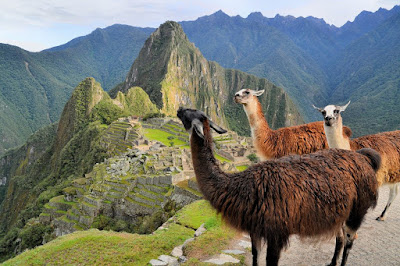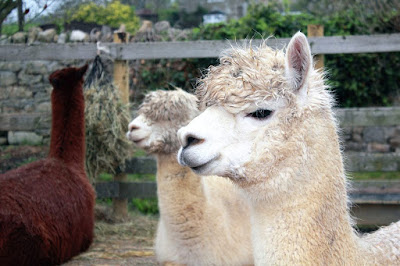Llamas are a member of the camelid family, which includes
camels, alpacas, vicunas, and guanacos. Historically, in the wild, they were
found in the Andes Mountains of South America, where they were farmed and
domesticated for hundreds of years for meat, milk, wool, and for use as pack
animals. They are now farmed in many countries worldwide.
The llama’s under-coat wool is known for its softness,
whereas the upper-coat wool (known as “guard hairs”) is a little coarser, and
serves to protect llamas from debris and rain. Both coats are used for weaving
into fibers. Llamas are social animals and live in herds. Read on to learn
about the llama.
Characteristics
The height of a full-grown, full-size llama is between 5.5
feet (1.6 metres) to 6 feet (1.8 metres) tall at the top of the head. Llamas
can weigh approximately between 280 pounds (127 kilograms) and 450 pounds (204
kilograms). At birth, a baby llama (called a cria) can weigh between 20 pounds
(9 kilograms) to 30 pounds (14 kilograms).
Llama ears are rather long and slightly curved inward,
characteristically known as banana shaped. There is no dorsal hump. Feet are
narrow, the toes being more separated than in the camels, each having a
distinct plantar pad. Their tail is short and their fibre is long, woolly and
soft.
Ecology
Also known as the "new world camel", llamas were
domesticated in the early 1500s and are valuable work animals.
They, like all camelids, differ from other mammals in that
their red blood corpuscles are oval instead of round. This adaptation allows
them to take in more oxygen, making them well suited to life at high altitudes.
Their coat is used to make cloth and other material goods.
In the wilds of South America, pumas (or mountain lions) are
llamas' only natural predator. In North America, cougars and bears have been
known to take llamas. In South America, thousands are used for meat each year.
Llamas are best known for their gentle character and the
ease at which they can be trained. This makes them versatile for a variety of
uses. They can often learn new tasks after only a few repetitions. Within the
herd, llamas communicate with gentle clucking, orgling or hums and ear and tail
movements. The llama’s alarm call is high-pitched and has been compared to the
sound a tropical bird’s call. Llamas use the alarm call when danger is present
or if they are alarmed by something. Llamas hum when they are uncomfortable or
overheated. If they are curious, worried, distraught or calling their young,
they also hum. Different pitches are used to differentiate the meaning of the
hum. Orgling is a sound similar to gurgling that males make when mating or when
he approaches a female. Clucking is used when flirting or meeting a new llama.
When a llama stretches very tall with their head held high,
with a rapid flicking of the tail, it usually indicates displeasure. This
behavior is common of a pregnant female who wants to detour an approaching
male. Llamas are known to spit at each other in self-defense. They will lay
back their ears and posture their head very high in the air prior to spitting.
Normally this is only directed toward other llamas in the herd, but
occasionally a llama will spit at a human if they have been mistreated or if
they object to something hurtful. The spitting or spraying behavior is used to
define pecking order in a herd, to show dominance.
Feeding
For Llamas that are raised on a ranch they are often fed
hay, grains, and various types of supplements. This diet is one that works well
for them to be able to grow and to develop like they should. The supplements
aid in reducing health problems and increasing the quality of the fibers that
are offered from the Llama fur.
In the wild grass, shrubs, and lichen are the items that
make up the diet for the Llama. They are grazers and can spend long periods of
time slowly consuming volumes of food. They move around to eat the shorter
grass and this helps to ensure that they don’t overgraze in any particular
area.
Diet
Llamas are herbivores, preferring to munch on low shrubs,
lichens, grasses, seeds, grains, roots and other mountain vegetation. They
graze throughout the day and, like cows, regurgitate their food and chew it as
cud. Because their natural habitat -- the Andean highlands in Peru -- is very
dry, llamas have adapted to small amounts of water. They only consume around
two to three gallons of water and only eat around 1 to 2 percent of their body
weight in food each day.
Facts On Reproduction
Lllamas are like stallions in that adult males left intact
can be difficult to handle, may pester and constantly try to mount females and
even other animals, and may fight, sometimes violently, with other intact
males. At two years of age, young male llamas sprout 6 new teeth designed
specifically for fighting, and appropriately called "fighting teeth."
These teeth, four on top, and two in the bottom jaw, are hooked, rearward
facing, and razor sharp. Male llamas will use them against eachother by
slashing at ears, legs, and even genitals! That's a real stunner as far as
llama facts go!
Fighting teeth are removed from most llamas as soon as they
come in, and most male llamas that are not used for breeding are gelded, just
like stallions, making them much safer to have around.
When breeding, a single male llama is usually kept with a
small herd of females, and without competition, things remain peaceful. Llamas
and alpacas are one of the few animals that mate with the female in a kush
position, lying with her legs folded under her. Female llamas have a long
pregnancy of 11 months. The other females will gather around the mother when
she's ready to deliver, calming her, and looking out for danger. She usually
has a two-part labor, where the head first appears, and then she may stand
around for a few minutes with the babies head and front feet protruding, before
pushing again. Llamas generally give birth standing up, and the baby is
stimulated by dropping to the ground.
The llamas tongue
doesn't stick out far from the mouth, so she doesn't lick the baby as most
mammal mothers do. They generally have a single baby, and the baby llama is
called a cria, which is a Spanish word for baby. The cria has incredibly long
legs, and can stand and walk within the first 40 minutes. Youngsters are weaned
by about 8 months old.
Please Share This Beautiful Animal..





















No comments:
Post a Comment